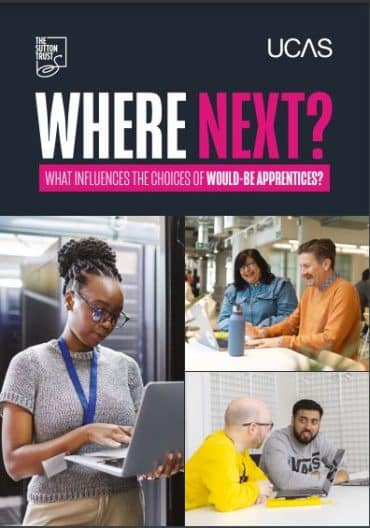Students’ progress from initial interest to starting an apprenticeship
- Discovery: Around half (46%) of student respondents considered apprenticeships an option for them while studying for GCSEs or National 5s and thinking about post-16 options, with those from lower socioeconomic backgrounds 6 percentage points more likely to do so (49% vs 43%). 70% of respondents also report having a positive initial perception of apprenticeships – with applicants and those interested having the most positive initial perception.
- Exploration: 41% of student respondents indicated that they had received the same or more information about apprenticeships than they did university options, with those from lower socioeconomic backgrounds more likely to report hearing more about apprenticeships than those from higher socioeconomic backgrounds. Equally, those students that went on to become apprentices report receiving more information about apprenticeships.
- Applying: Generally speaking, respondents had a negative experience of applying for apprenticeships, with 50% of apprentices saying their experience of applying was positive, compared to 90% of placed university and college applicants. At present, there isn’t a central application service for apprenticeships, meaning that applying for multiple opportunities can be burdensome – and the more opportunities students apply for, the less satisfied they are. Furthermore, we observe disparities in support for students – with 1 in 3 apprentices from a lower socioeconomic background receiving no support with their application.
- Entry: The concept of ‘earn while you learn’ was a popular area of interest for students – with those from lower socioeconomic backgrounds being eight percentage points more likely to cite pay as a top research topic than those from higher socioeconomic backgrounds (31% vs 23%). While for some, pay can act as a key attraction to becoming an apprentice, for others this can also be a barrier – a quarter (24%) of former applicants said that one of the top three reasons why they did not pursue an apprenticeship was because they felt they could not afford to do so.
- Experience: Overall, apprentices were positive about their experience, and 63% were likely to recommend this route to family or friends, with those in engineering or business and administration most likely to do so. However, younger apprentices were less likely to recommend this route. In addition, 1 in 3 said their apprenticeship was not what they thought it would be like.
Awareness and access to apprenticeships and higher education
- Ambition: 1 in 3 students consider university as early as primary school, with advantaged students 40% more likely to do so. However, for apprenticeships, this figure is less than 5% – meaning around one student in the average primary school class. This highlights the aspiration divide.
- Access: Disadvantaged students are more likely to be interested in apprenticeship options, with 46% from the most disadvantaged areas interested in this route, compared to 41% from the most advantaged areas. Furthermore, those from lower socioeconomic backgrounds (63%) are more likely to have considered apprenticeships while thinking about post-16 options than those from higher socioeconomic backgrounds (51%). However, despite this level of interest, we still see significant disparities in entry – with the Sutton Trust reporting that twice as many degree apprentices are from the wealthiest areas compared to the poorest, indicating disparities in entry by background.
- Connection: Students find it challenging to explore and connect to apprenticeship opportunities. 3 in 4 students find it easy or somewhat easy to find information about applying for university study – compared to 1 in 4 for apprenticeships. Furthermore, those that applied for an apprenticeship found the process arduous as they applied for multiple opportunities, suggesting the current process stifles choice. In contrast, the single application from UCAS promotes choice and provides an overall more positive experience.
- Opportunity: Each year, over half a million students enter full-time undergraduate study, with the entry rate of 18 year olds across the UK ranging from 30% – 41%. However, for apprenticeship opportunities, whilst we see significant demand, the number of starts for young individuals at Level 4 and above is less than 5,000, some of which will be existing employees. Furthermore, our report finds a number of students do not pursue an apprenticeship opportunity because they cannot find one in their preferred subject or location.
- Award: 76% of students view university degrees as ‘prestigious’ compared to just 4% for apprenticeships. This is despite undergraduate courses and Degree Apprenticeships offering the same award.
